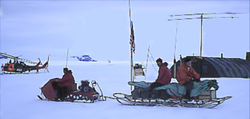Byrd station
| Byrd station | ||
|---|---|---|
|
|
||
| Coordinates | 80 ° 1 ′ S , 119 ° 32 ′ W | |
| Basic data | ||
| Country | Antarctica | |
| ISO 3166-2 | AQ | |
| founding | 1957 | |
|
Byrd station around 1960
|
||
The Byrd Station is a former polar research station of the United States in West Antarctica . It was built by the US Navy during the International Geophysical Year 1957 as part of Operation Deep Freeze II in Marie Byrd Land and is named after the US polar explorer Richard Evelyn Byrd .
history
In a joint operation by the US Army , Marines and Air Force , at the end of 1956, starting from the Little America V station built on the Ross Ice Shelf , an overland crossing by means of a snow tractor convoy into the interior of Marie Byrd Land was started. The convoy was led by Army Major Merle Dawson (1906-1986) and laid a path over 1040 km of previously unexplored land to a pre-selected end point. The research facility, planned as a year-round station for 25 people, initially consisted of four and later a total of 11 prefabricated buildings. The former were erected in less than a month by a unit of the US Navy Seabees on the inland ice at an altitude of 1,528 m . Commissioning took place on January 1, 1957. The original station ("Old Byrd") collapsed after four years under the load of snow. In 1960, the construction of an underground station began, which was used until 1972. The station was then converted into a field camp that was only used in summer until it was completely abandoned in 2004/05.
The National Science Foundation , responsible for the United States Antarctic Program , had plans for successor facilities in West Antarctica. Starting in June 2009, a new camp at a distance of around 1400 km from the main base, the McMurdo Station , was to support a number of scientific projects, which also included investigations on the Pine Island Glacier . It should ensure the supply of up to 50 people and in particular serve as a refueling station for support flights. A second field camp was to be built near the Pine Island Glacier for a project led by NASA scientist Robert Bindschadler to support helicopter flights towards the ice shelf.
climate
In recent years, the station has recorded a warming of the climate, with the greatest effect in winter and spring. The area in the center of the West Antarctic Ice Sheet is one of the most warming places on earth.
Web links
- The Antarctic Sun (Online newspaper of the US Antarctic Program)
- Automatic weather station website
Individual evidence
- ^ A b The Antarctic Sun: Byrd History, June 12, 2009 . The Antarctic Sun .
- ^ A b c John Stewart: Antarctica - An Encyclopedia . Vol. 1, McFarland & Co., Jefferson and London 2011, ISBN 978-0-7864-3590-6 , p. 258 (English)
- ^ Frazier, PW, 1957, Across the Frozen Desert to Byrd Station: National Geographic Magazine, v. CXII, p. 383-398.
- ^ The Antarctic Sun: Byrd Camp Resurfaces, June 12, 2009 . The Antarctic Sun.
- ^ The Antarctic Sun: Going to the Edge, November 22, 2007 . The Antarctic Sun.
- ^ West Antarctica warming fast; Temperature record from high-altitude station shows unexpectedly rapid rise December 21, 2012, Science News

